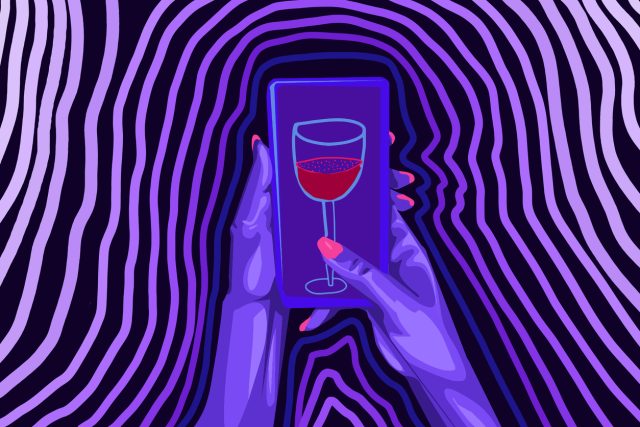While some commentators see the current downturn as a temporary blip, the data paints a more complex picture. Shifting demographics, changing values and declining engagement suggest wine’s challenges may be structural rather than cyclical.

Jamie Goode wants you to know wine is still cool. In his recent column for Winemag,¹ the London-based wine writer acknowledges the industry’s struggles but argues we’re just in a “temporary sticky patch.” Visit any natural wine fair, he observes, and you’ll find it packed with young people. The problem, in his view, isn’t wine – it’s economics.
I’d like that to be true. Let’s take a look at the numbers.
Fine wine prices fell 11% across major regions in 2024.² The broader wine market saw volumes drop 5% that same year, with wine suffering the steepest declines across all alcohol categories.³ Between 2021 and 2024, the number of wine drinkers in key global markets fell by five million people, despite adult populations growing.⁴ In the US alone, the population increased by 9.5 million since 2022. Monthly wine drinkers? Up just 500,000.⁵
The cultural shift
Goode attributes wine’s troubles to “rising costs at both ends of the market” and “genuine erosion of purchasing power” – temporary economic headwinds, in other words. But this explanation doesn’t account for what’s happening culturally. Gen Z is re-engaging with alcohol – participation rates jumped from 46% to 70% in the US between 2023 and 2025, and in the UK, up from 60% to 70%.⁶ They’re just not choosing wine. They want spirits, hard seltzers, and ready-to-drink cocktails.⁷ When they do buy wine, it’s sweet, sparkling, or both.
Meanwhile, 65% plan to drink less in 2025, with 58% citing mental health as their reason.⁸ This isn’t primarily about affordability. It’s about values.
The limits of natural wine’s success
The natural wine scene Goode celebrates is genuine: venues grew 60% in three years, and organic wine is expanding at 10-12% annually.⁹ ¹⁰ But in France, natural wine represents just 2% of production.¹¹ It’s a vibrant niche that cannot offset the broader decline. And framing wine’s problems as temporary requires setting aside that fine wine prices have been falling for two consecutive years, on-premise sales remain below 2019 levels and industry analysts don’t expect inventory resets until 2026 at the earliest.¹²
Where will tomorrow’s wine drinkers come from?
The deeper question Goode sidesteps: where do tomorrow’s fine wine drinkers come from? Wine literacy has always developed through progression – cheap bottles in your twenties, gradual trading up as palates mature and incomes rise. If Gen Z isn’t developing that foundation, the pipeline breaks. The commodity market that Goode acknowledges as “most wine” is the training ground for future enthusiasts. Without it, the “interesting wines” he champions have no audience in waiting.
Inside the industry echo chamber
Goode’s market segmentation framework is genuinely useful. But his evidence comes largely from within wine’s own ecosystem – McLaren Vale producers, Adelaide bottle shops, natural wine fairs. The festivals are full because that’s where enthusiasts gather. The bottle shops thrive because they serve the converted. For someone with a PhD in plant biology who worked as a science editor, this feels like an oversight: he’s dismissing generational cohort data as marketing shorthand while building his case on anecdotal observation from self-selected samples.
What the broader data shows
The supermarkets where most wine is actually sold tell a different story. So do the aggregate sales figures, the demographic studies and the on-premise data. Mature markets are becoming increasingly reliant on older generations to drive volume, while experienced drinkers remain loyal but less engaged and spend less than younger consumers.¹³ US alcohol participation among adults 21 and older has dropped to 58% – the lowest level since 1996.¹⁴ Industry analysts project wine volumes will continue declining in most key markets through at least 2028.¹⁵
A shrinking, ageing market
The fine wine market isn’t just correcting – it’s also consolidating. It’s contracting demographically. When growth depends entirely on a shrinking cohort of existing believers, that’s not resilience. That’s a speciality market in decline.
References:
¹ Jamie Goode, “Has wine lost its cool – for good?”, Winemag, August 5, 2025, https://winemag.co.za/wine/opinion/jamie-goode-has-wine-lost-its-cool-for-good/
² WineCap, “Report – Opportunities in uncertainty: the 2024 fine wine market and 2025 outlook,” https://winecap.com/learn/report-opportunities-in-uncertainty-the-2024-fine-wine-market-and-2025-outlook
³ NIQ, “2024 Beverage Alcohol Year in Review,” https://nielseniq.com/global/en/insights/analysis/2025/2024-beverage-alcohol-year-in-review/
⁴ IWSR, “Five key trends defining opportunities in the global wine market in 2025,” https://www.theiwsr.com/insight/five-key-trends-defining-opportunities-in-the-global-wine-market-in-2025/
⁵ Ibid.
⁶ IWSR, “Don’t blame Gen Z: as challenges persist, younger legal-drinking-age consumers are re-engaging with alcohol,” https://www.theiwsr.com/insight/dont-blame-gen-z-as-challenges-persist-younger-legal-drinking-age-consumers-are-re-engaging-with-alcohol/
⁷ IWSR, “How might Gen Z reshape beverage alcohol in the US?”, https://www.theiwsr.com/how-might-gen-z-reshape-beverage-alcohol-in-the-us/
⁸ NCSolutions, “Sober Curious and Alcohol Statistics | 2025 Trends,” https://ncsolutions.com/the-goods/sober-curious-nation-alcohol-survey/
⁹ Raisin, “Natural Wine Market Analysis: 2016 to 2024,” https://www.raisin.digital/en/news/natural-wine-market-analysis-2016-to-2024-1085/
¹⁰ Grand View Research, “Organic Wine Market Size And Share | Industry Report, 2030,” https://www.grandviewresearch.com/industry-analysis/organic-wine-market-report
¹¹ Raisin, “Natural Wine Market Analysis: 2016 to 2024” https://www.raisin.digital/en/news/natural-wine-market-analysis-2016-to-2024-1085/
¹² Silicon Valley Bank, “2025 State of the US Wine Industry Report,” https://www.svb.com/globalassets/library/uploadedfiles/wine/svb-state-of-the-us-wine-industry-report-2025.pdf
¹³ IWSR, “Five key trends defining opportunities in the global wine market in 2025”
¹⁴ Penn State Extension, “Alcoholic Beverage Trends 2025,” https://extension.psu.edu/alcoholic-beverage-trends-2025
¹⁵ IWSR, “Five key trends defining opportunities in the global wine market in 2025”
Related news
Comment: Asia’s 50 Best Bars 2025 signals a shift in the region’s cocktail hubs
Comment: Diageo shuts down Guinness and Moët Hennessy sale rumours
Comment: how wine brands targeting India can improve their aim


Dining and Cooking